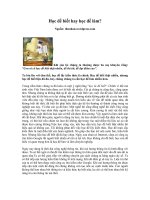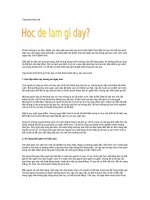Học không được hay học để làm gì bản tóm tắt
Bạn đang xem bản rút gọn của tài liệu. Xem và tải ngay bản đầy đủ của tài liệu tại đây (3.84 MB, 4 trang )
HủC
KHĐNG
òảỳC
HAY
HủC òế
LM Gỗ
Tri nghiồm hủc tĩp cỷa thanh
thiu niÊn dÂn túc thiếu s
Trong gôn ba thp k qua, Nhà nèc và cc că quan tấ chc pht trin trong
nèc cng nh quậc t ặ và ặang n lc trin khai hàng lot ặ n, chnh sch
lin quan trc tip ặn gio dc và ặào to nhêm to ngun xây dng ặẩi ng lao
ặẩng, tr thc dân tẩc thiu sậ. Th nhng, theo ặnh gi gôn ặây nht cềa ỷy
ban Dân tẩc th ngun nhân lc vễng dân tẩc và min ni cn thiu v sậ lểng
và yu v cht lểng (ò n CEMA 2011). Xọt dèi kha cnh gio dc, cc chăng
trnh xây dng và pht trin ch trng vào "phôn cng" nh trng hc, hc ph, tn
dng h trể và dy ngh vn cha thc s gii quyt thu ặo cc rào cn và kh
khđn dn ặn t lữ hc sinh dân tẩc thiu sậ càng ln bc hc cao càng gim dôn.
Nhêm gp phôn tm li gii ặp cho vn ặ nu trn, trong khun khấ thi gian
c hn, nhm nghin cu tin hành kho st kt hểp vn dng cc phăng php
nghin cu ặnh tnh nhân hc ti bận cẩng ặng dân tẩc thiu sậ (ngi Thi,
Dao, Pà Thn và Hmng) thuẩc ặa bàn cc tnh Hà Giang, Yn Bi và òiữn Bin.
òậi tểng tham gia phãng vn sâu và tho lun nhm cẩng ặng bao gm hc
sinh, ph huynh, gio vin, hiữu trẻng trng, ặim trẻng, ngi lao ặẩng, cn
bẩ x và nhng ngi tng lao ặẩng, tm viữc ti cc thành phậ, trung tâm ặ th.
?
Tri nghiữm
hc tp cềa
thanh thiu nin
dân tẩc thiu sậ
Mẩt em hc sinh trong buấi hc ặnh vôn ch Khmer cềa lèp 3, trng tiu hc òi Tâm 2.
Tc gi: Danh De (Dân tẩc Khmer, X òi Tâm, Huyữn Má Xuyn, Tnh Sc Trđng)
Mẩt trong nhng pht hiữn nấi bt cềa nghin cu cho thy vn ặ khng hoàn
toàn ẻ bn thân cc thanh thiu nin và cẩng ặng dân tẩc thiu sậ ặểc phãng
vn khng c thc hc tp cao và nguyữn vng mẻ rẩng cc la chn sinh k, mà
rào cn lèn nht chnh là s thiu cng bêng ặ ngi dân tip cn cc că hẩi ặ.
Mậi quan ngi chề yu cềa hc sinh ln ph huynh ti cc ặa bàn nghin cu là
ẻ kh nđng tip cn cc că hẩi hc tp và viữc làm (thng là sau khi tật nghiữp
bc THPT). Nhng v d trc quan ti cc cẩng ặng thiu sậ v con em nng dân
bnh thng hc xong khng xin ặểc viữc làm ấn ặnh chnh là rào cn tâm l
v cễng lèn khin c ph huynh và hc sinh t c ặẩng lc vểt qua rt nhiu kh
khđn, ặc biữt v kinh t ặ tip tc hc ln cao.
Quan trng hăn, nghin cu ch ra rêng cc cẩng ặng dân tẩc t ngi him
c că hẩi tip cn thng tin, ặc biữt là cc că hẩi h trể hc tp và u tin viữc
làm, so vèi ngi Kinh hay cc nhm dân tẩc thiu sậ nhng chim sậ ặng trn
ặa bàn. Yu tậ cật li dn ặn tnh trng thiu cng bêng că hẩi này xut pht t
chnh nhng ặnh kin v khc biữt tẩc ngi, gia tẩc ặa sậ và cc tẩc thiu sậ,
gia cc tẩc thiu sậ ặng ngi và cc tẩc thiu sậ t ngi. Bêng chng cho thy
mẩt xu hèng là nhng tẩc ngi thiu sậ c t lữ dân c ặng hăn, c lch s và
tp qun c tr lâu dài thng c kh nđng tip cn cc ặc quyn ặc lểi, trong
khi ặ cc nhm "thiu sậ t ngi" vn lun b, hay thm ch t coi h là nhn
thc kọm, lc hu và ngi va chm nn càng gp bt lểi hăn. Hiữn tểng này cho
thy vn ặ ặnh kin tẩc ngi bẩc lẩ ẻ nhng dng thc tinh t, trong kh nđng
và că hẩi ặ tip cn cc v tr "chật" quan trng và tật hăn khng ch gia tẩc ặa
sậ vèi cc tẩc thiu sậ mà cn gia cc tẩc ngi thiu sậ khc nhau. òây là mẩt
biu hiữn và hữ ly t mậi quan hữ lin tẩc ngi c tnh lch s vđn ha ht sc
ặc thễ ẻ vễng ặa dân tẩc và min ni pha Bổc Viữt Nam.
Tnh trng thiu cng bêng trong viữc tip cn cc că hẩi hc tp-viữc làm ni trn li phn nh nhng tn ti bt cp trong
cch thc trin khai cc chnh sch ti ặa phăng. Theo nhng thng tin thu thp ặểc th viữc trin khai cc chnh sch lin
quan ặn pht trin ngun nhân lc ẻ nhiu ặa phăng vễng dân tẩc và min ni cn thiu tnh minh bch, nng v hnh thc
nn thiu hiữu qu. Ngi dân khng ặểc cp nhp và tip cn mẩt cch chnh thc cc chnh sch và ch ặẩ u ặi nh
ặđng k hc trng dân tẩc nẩi tr, c tuyn bc cao ặng hay ặi hc... Cc chăng trnh dy ngh vn ch b hóp trong phm
vi to cng đn viữc làm ti ặa phăng, nhng li xa ri vèi thc t cềa th trng lao ặẩng và kh nđng ặôu t cềa ngi dân.
Trn că sẻ phân tch vn ặ hc tp cềa thanh thiu nin dân tẩc thiu sậ trong mậi tăng quan gia ba cp ặẩ: tẩc ngi
chề th; lin tẩc ngi (ti ặa phăng) và trung ăng-ặa phăng, nghin cu bèc ặôu cho thy nhng nguyn nhân sâu xa
ằn sau ặẩng thi ngh hc và khng hc tip ln cc bc cao cềa hc sinh vễng ặa dân tẩc và min ni.
Đng òng Kim Săng, 48 tuấi, thn Sài Lăng, X Nm Bng ặang vit ch nho. Tc gi: Triữu Vđn Kim (Dân tẩc Dao, X Nm Bng, Huyữn Vđn Chn, Tnh Yn Bi)
KIN NGHở GII PHẫP
- Côn gây dng và cềng cậ nim tin v cc că hẩi hc tp và
ngh nghiữp cho ngi dân tẩc thiu sậ, t ặ to nn ặẩng că
thc ặằy c ph huynh và hc sinh n lc phn ặu theo hc ln
bc cao. Thng tin phấ bin cng khai, nhanh chng và rẩng ri
cho mi ặậi tểng ặểc bit.
- V mt chnh sch tuyn dng, ặc biữt ti cc khu vc nng
thn min ni, côn xa bã hnh thc "bin ch" cng nh gim
thiu cc khâu thề tc hành chnh khi xin nẩp và xọt tuyn ngh
nghiữp ặ ngđn tr môm mậng, to ặiu kiữn pht sinh cc hiữn
tểng tiu cc.
- Phấ bin cc m hnh, cc tm găng "thành cng" (trong hc
tp và ngh nghiữp) ẻ ặa phăng.
- Côn h trể cc yu tậ c tnh "phăng tiữn" cđn c trn nhu
côu thc t tng vễng, ặa phăng ặ to ặiu kiữn cho tr em
dân tẩc thiu sậ ặn trng hc tp (cc ặim trng, gio vin
tiu hc cễng nhm tẩc ngi, p dng thi ặim thu hc ph
uyn chuyn hăn).
- Lp quá khuyn hc trong cc cẩng ặng, nu cao tinh thôn
tăng trể và ặ cao vai tr cềa già làng, ngi c uy tn trong
thn bn trong viữc khuyn khch hc tp nhêm hèng tèi lểi
ch chung cềa cẩng ặng.
- Thng qua cc phăng tiữn truyn thng, hot ặẩng tấ chc
cc s kiữn vđn ha mang tnh ặi chng tđng cng cng tc
tuyn truyn, gio dc nâng cao thc ngi dân tn trng s
ặa dng vđn ha tẩc ngi ặ cềng cậ khậi ặi ặoàn kt dân tẩc,
ặng thi gp phôn xa m tâm l t ặnh kin và t ti cềa cc
nhm dân tẩc thiu sậ, nht là cc cẩng ặng "thiu sậ t ngi".
Thng tin chi tit v kt qu nghin cu và ặ xut chnh sch ặểc tp hểp trong bo co "Hc khng ặểc hay hc ặ làm g?"
Nghin cu do Viữn Nghin cu X hẩi, Kinh t và Mi trng (iSEE) và tấ chc CARE quậc t ti Viữt Nam phậi hểp thc hiữn
ti ba ặa bàn ặi diữn cho min ni pha Bổc Viữt Nam là Yn Bi, Hà Giang và òiữn Bin.
MủI THĐNG TIN XIN LIÊN Hồ
Ch V Phăng Tho
Email: - òiữn thoi 04-62737933 / 0989756681
Learning
experience
of young ethnic
minority people
Unable
to learn or
unmotivated?
In the last three decades, the Vietnamese Government and local and international
development agencies have put great efforts in implementing several education
and training policies to develop ethnic minorities' workforce and intellectuals. However, the most recent assessment by Committee of Ethnic Minorities indicated that
workforce in ethnic and mountainous area was still in "low quality and quantity"
(Proposed Strategy - CEM 2011). From educational perspective, the programmes focusing on "hardware" parts such as providing schools, credit, and vocational training
have yet to resolve the problems that lead to dropouts at higher grades and poor
quality of education of ethnic minority children.
In order to find answers to the problem, the research team, within a limited timeframe, conducted a qualitative study using anthropological approach in four ethnic
minority communities (Thai, Dao, Pa Then and H'Mong) in Ha Giang,
Yen Bai and Dien Bien Provinces. Participants in focus group discussions and
in-depth interviews were students, parents, teachers, headmasters, heads of school
units, labourers, local authorities and labourers who had returned after working in
cities or townships.
A third grade pupil of Dai Tam 2 Primary School in Khmer learning hour.
Photo author: Danh De (Khmer Ethnic Group, Dai Tam Commune, My Xuyen District,
Soc Trang Province)
One of the main findings of the research was: not the lack of awareness and
desire to expand livelihood options among ethnic minority youths and communities
are causes of the problem. The key issue was inequality in accessing opportunities.
The major concern of students and parents at research areas was accessibility to
learning and working opportunities (usually upon high school graduation). At ethnic minority communities, examples of ordinary farmers' children unable to find a
stable job after graduation has been a huge mental barrier for both students and
parents who would have little motivation to overcome several difficulties, especially
economic one, to pursuit higher education.
More importantly, the research also indicated that ethnic minority groups with
very small population had less access to information on educational support opportunities and job incentives than the Kinh and the ethnic minority groups that have
bigger population (the majority of minority groups) living in the same geographical area. The main cause for the above mentioned inequality was ethnical stigma
between ethnic groups.
More importantly, the research also indicated that ethnic minority groups with
very small population had less access to educational support opportunities and job
incentives than the Kinh and the minority groups that have bigger population in the
same geographical area. The main cause for this unequal access to opportunities
was ethnical stigma between the majority and the minorities, and also between
minorities with bigger population and minorities with smaller population. There is
evidence that minorities with bigger population and longer history of inhabitance
usually have better access to privileges than minorities with smaller population,
who are believed, by other groups or by themselves, to be backward and slow in
learning.
The phenomenon suggested that ethnical stigma is demonstrated in a very subtle manner, not only between majority and minority
ethnic groups but also between different ethnic minority groups. In this case, it is demonstrated in capability and opportunity to get
access to key and better positions. The situation was the expression and consequence of typical historical and cultural inter-ethnic
group relation in the northern mountains of Vietnam.
On the other hand, the mentioned inequality in accessing education and employment opportunities reflected existing irrelevancy
in policy implementation at local levels. According to collected information, the implementation of human resource policies in many
ethnic and mountainous localities still lack transparency, and was supericial and ineficient. Ordinary people were not updated or
informed formally about many policies such as boarding schools and boarding schools and nomination for tertiary education. Vocational training programs are limited to creating jobs locally, but fall far short of the real needs of the labour market and do not take
into account people's investment capability.
When analyzing education situation of young ethnic minority people in the relationship among three levels: majority ethnic group,
inter-ethnic groups (at locality) and central-local level, the research revealed more important underlined reasons for dropouts or
discontinuation to higher education of ethnic young people in mountainous areas.
Mr. Dang Kim Suong, 48 years old at Sai Luong Village, Nam Bung Commune; was writing Chu Nho (a type of script used to write Yao language).
Photo author: Trieu Van Kim (Yao ethnic group, Nam Bung Commune, Van Chan District, Yen Bai Province)
RECOMMENDATIONS
Build up and reinforce trust on learning and working opportunities for ethnic minorities, and consequently create motivation
for parents and students to pursuit higher education. The information should be made public, timely and to everyone.
On recruitment process, especially in mountainous rural areas,
it is recommended to remove "life time staffing form" (bien che)
and simplify administrative procedures in applying and assessment to reduce bribe/corruption chances.
Highlight and amplify successful examples in learning and
working from real life.
Provide "utility" supports based on actual needs to create
favourable conditions for ethnic minority children to go to school
(such as school units, primary school teachers from the same
ethnic groups, flexible tuition scheme).
Create education fund in communities and promote mutual
support as well as promote head of villages' roles in encouraging
education for benefits of the whole community.
Through media and public culture events, raise public awareness of respecting culture diversity with an aim to strengthen
solidarity and remove stigma against and self-stigma of ethnic
minorities, especially groups with smaller population
Details about the research findings and policy recommendations are available in the report "Unable to learn or unmotivated."
The research was done by the Institute for Studies of Society, Economic and Environment (iSEE) and CARE International.
For further information please contact:
Ms. Vu Phuong Thao
Email:
Phone: 04-62737933 / 0989756681
www.isee.org.vn

![[Bàn luận] Học để làm gì?](https://media.store123doc.com/images/document/13/pt/za/medium_zau1376682526.jpg)







